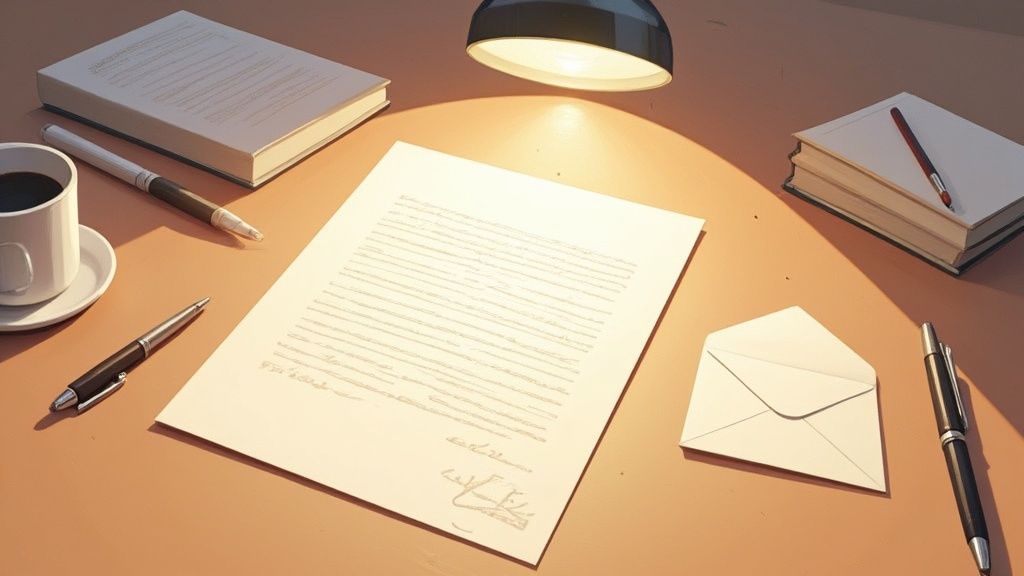
How to Write a Cover Letter That Lands Interviews
Think of a cover letter as the story your resume can’t tell. It’s a one-page document that does more than just list your skills; it introduces you to a real person, highlights your most relevant qualifications, and shows your genuine interest in a specific role. Your goal is to draw a clear line between your experience and what the company needs, convincing them you’re the right person to talk to.
Why Your Cover Letter Still Matters
Let’s be honest—you’ve probably wondered if anyone even reads cover letters anymore. It’s a fair question in a world of one-click applications and automated screening.
The short answer? Yes, they absolutely do. Skipping this step is one of the biggest missed opportunities in a job search. While your resume lists what you’ve done, a cover letter explains why it matters for this specific job.
A compelling letter is your chance to stand out in a sea of nearly identical resumes. It’s where you build a narrative, connecting the dots between your past wins and the company’s future goals. This is especially critical when your resume doesn’t perfectly align with the job description, like if you’re changing careers or looking for your first professional gig.
The Human Element in a Digital Process
Hiring managers aren’t just looking for qualifications; they’re searching for personality, drive, and a real interest in their company. A personalized cover letter is your best tool for conveying these qualities. It signals that you’ve done your homework and aren’t just blasting your resume out to every open position you find. That effort makes a huge difference.
- It Shows You’re Genuinely Interested: A letter tailored to the company’s mission, values, or a recent project proves you’re invested.
- It Provides Important Context: You can explain an employment gap, clarify your reasons for a career pivot, or expand on a key project you only briefly mentioned on your resume.
- It Showcases Your Communication Skills: Clear, persuasive writing is a must-have skill in almost every industry. Your letter is their first sample of your work.
A well-crafted cover letter acts as a bridge between your resume and the hiring manager. It’s your first and best chance to prove you’re not just a list of skills, but a motivated problem-solver who understands what the company is looking for.
Backed by Data: The Enduring Importance of Cover Letters
The debate over cover letters isn’t just talk; the data consistently shows they remain a crucial part of the hiring equation. Here’s a quick look at why they still pack a punch.
Cover Letter Impact Quick Facts
| Statistic | What It Means for You |
|---|---|
| 83% of hiring managers read cover letters, even when optional. | The overwhelming majority of decision-makers are looking for the extra context your letter provides. Skipping it means you’re missing a chance to influence them. |
| Recruiters spend an average of 30 seconds on each letter. | Your letter needs to be scannable and impactful from the very first sentence. Every word counts. |
| 94% of hiring managers say cover letters influence interview decisions. | This is your single best opportunity to tip the scales in your favor and secure an interview. |
These numbers tell a clear story: a thoughtful cover letter is still one of the most powerful tools in your job search toolkit.
This infographic breaks down just how much a cover letter can impact your application in today’s job market.
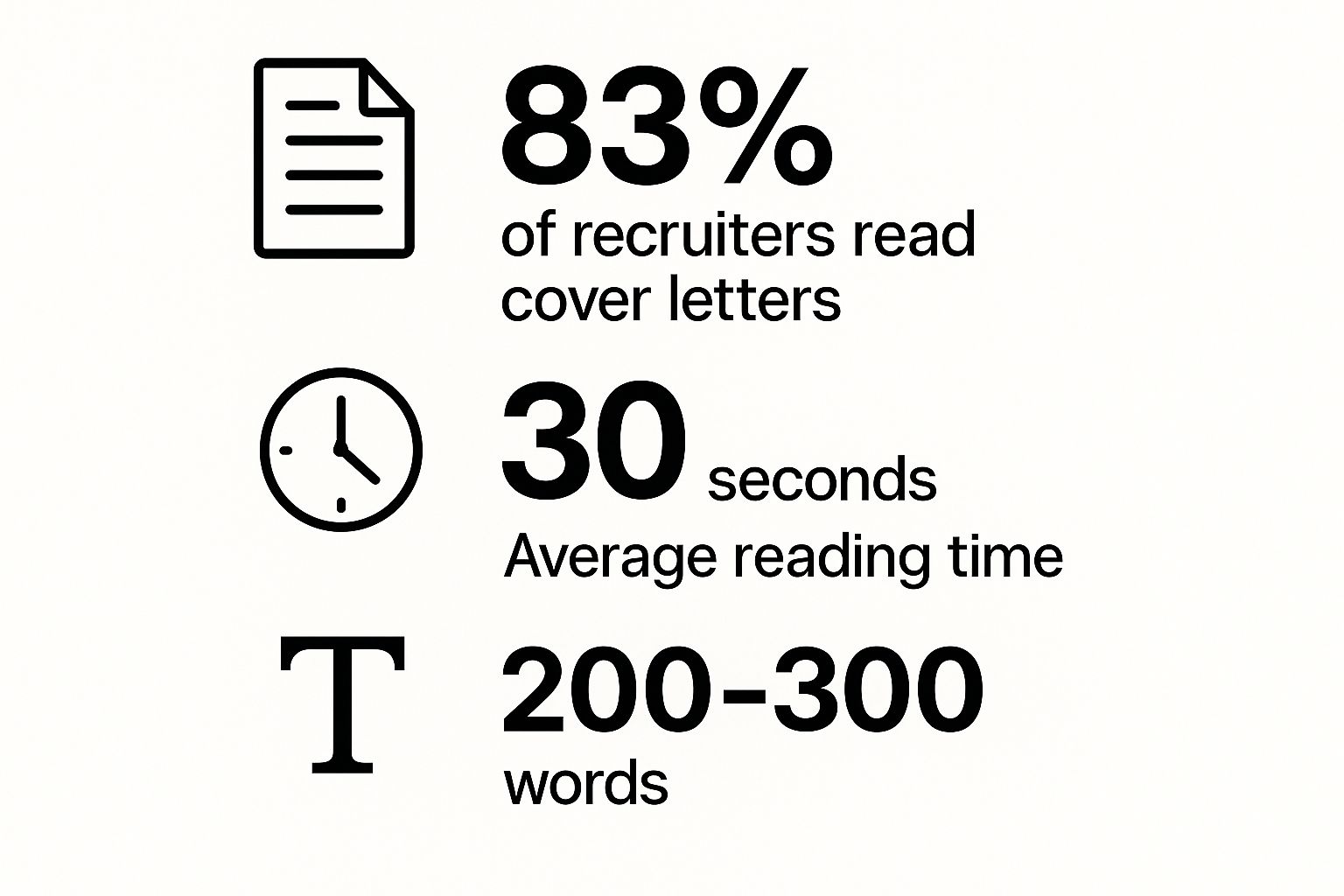
The key takeaway is that while a recruiter might only spend 30 seconds on your letter, those seconds are incredibly influential. The impact becomes even clearer when you realize 94% of hiring managers confirm that cover letters sway their interview decisions. You can explore more cover letter statistics to see just how much they can shape your application strategy.
Making That Critical First Impression
Your opening paragraph is your make-or-break moment. With recruiters spending so little time on each application, your introduction has to grab their attention immediately and make them want to keep reading.
A generic opener like, “I am writing to apply for the position of…” is a surefire way to get lost in the shuffle.
Instead, a powerful first paragraph should accomplish three things: state the role you’re targeting, showcase a major achievement that proves your value, and express authentic enthusiasm for the company. This approach immediately tells the hiring manager who you are, what you can do, and why you want to do it for them. Getting this right sets a positive tone for the rest of your application and can be the difference between getting an interview and being overlooked.
Building Your Cover Letter, Piece by Piece
Think of your cover letter as the story behind your resume. Each section has a specific job to do, and when you get them right, they work together to make a compelling case for why you’re the perfect fit. This isn’t about just filling in a template; it’s about understanding the strategy behind each part—the header, the greeting, the opening, the body, and the closing.
Once you nail these fundamentals, you’ll know how to write a cover letter that actually gets a response.
Start with a Clean, Professional Header
The header is the easiest part to get right, but it’s your first impression. It needs to be clean, easy to scan, and give the recruiter everything they need to contact you without any fuss.
Make sure your header includes these key details:
- Your Full Name and Professional Title: It helps to use the same title as the role you’re applying for (e.g., “Digital Marketing Specialist”).
- Your Contact Information: A professional email and your phone number are essential.
- Your Location: City and state are all you need. Forget the full street address—it’s outdated.
- Relevant Links: A link to your LinkedIn profile is standard practice. If you’re in a creative or technical field, your online portfolio is a must.
After your info, add the date, and then the recruiter’s details: their name, title, company name, and address. This might seem like a small thing, but that attention to detail shows you’re a serious professional.
The Greeting: Find a Real Person
“To Whom It May Concern” is the kiss of death for a cover letter. It immediately signals a generic, copy-paste application. The single best thing you can do to stand out is to address your letter to a specific person. It creates an instant connection and proves you’ve done your homework.
Finding the hiring manager’s name is easier than you think. A few minutes of digging can make all the difference.
How to Find the Hiring Manager
- Check the Job Post: Sometimes, their name is right there in the description.
- Search on LinkedIn: Look for the head of the relevant department. If it’s a software engineering role, search for the “Engineering Manager” or “Director of Engineering” at that company.
- Visit the Company Website: The “Our Team” or “About Us” page is often a goldmine for finding team leads and department heads.
Pro Tip: Once you find the right person, stick to a formal salutation like “Dear Mr. Smith,” or “Dear Ms. Chen,”. If you’re not sure about their gender or preferred title, just use their full name. “Dear Alex Johnson,” is a perfectly safe and modern option.
What if you’ve searched everywhere and still come up empty? Don’t panic. Instead of a generic greeting, get as specific as you can by addressing the role or team.
- “Dear Hiring Manager”
- “Dear Marketing Team”
- “Dear Acme Corp Hiring Team”
This is a much stronger fallback than an old-fashioned, impersonal phrase. It shows you still tried.
Craft an Opening Paragraph They Can’t Ignore
You have about seven seconds to convince a recruiter your cover letter is worth their time. Your opening paragraph is your hook, and a boring start like, “I am writing to apply for the position of…” will get your application tossed into the “no” pile.
Your opening needs to accomplish three things, fast:
- Name the role you want.
- Hit them with a powerful, measurable achievement that proves your value.
- Show genuine, specific excitement for this company or this role.
Let’s look at the difference.
A Generic Opening: My name is Sarah, and I am applying for the Social Media Manager position I saw on LinkedIn. I have five years of experience in social media and believe I am a good fit.
A Compelling Opening: Dear Ms. Davis, I am thrilled to apply for the Social Media Manager position at InnovateTech. In my previous role at a SaaS startup, I grew our organic social media engagement by 300% in just one year, and I am excited by the prospect of bringing that same data-driven creativity to your team’s mission to demystify AI for small businesses.
See the difference? The second example immediately shows what Sarah can deliver and why she cares about their company. That’s how you get noticed.
The Body Paragraphs: Connect Your Skills to Their Needs
This is where you make your case. The body of your letter is where you draw a direct line between your experience and the company’s problems. Don’t just list your accomplishments; show them you understand what they’re looking for and that you are the solution.
Scour the job description and pull out the top 2-3 most important requirements. Dedicate a short paragraph to each one. A great way to structure these stories is to talk about the problem, the action you took, and the result you achieved.
For instance, if the job description mentions needing someone with “experience launching new products,” you could write something like this:
At my last company, we were struggling to create buzz for a new software release. I developed and ran an influencer marketing campaign from the ground up, which led to over 50+ media mentions and boosted pre-orders by 40% compared to our previous launch. I see a huge opportunity to amplify your upcoming product release and am confident I can drive similar results here.
This approach doesn’t just tell them what you did—it shows them the tangible value you bring.
The Closing: End with Confidence
Your final paragraph is your chance to wrap things up and steer them toward the next step. You want to leave them with a clear idea of what to do next.
A strong closing should:
- Briefly restate your value: A quick summary of why you’re the right person for the job.
- Reaffirm your enthusiasm: One last, confident statement about your interest in the role.
- Include a call to action: Politely and directly ask for an interview.
Finish it off with a professional sign-off like “Sincerely,” or “Best regards,” followed by your full name. A confident, proactive closing leaves a great final impression and makes it easy for them to say yes to an interview.
The Art of Personalizing Your Message
Let’s be blunt: a generic cover letter is the fastest way to get your application tossed in the virtual trash. If you’re just swapping out the company name and job title, you’re squandering the single best opportunity you have to stand out. Real personalization isn’t about find-and-replace; it’s about showing you have a genuine, specific interest in this company and this role.
This goes way beyond superficial tweaks. It’s about proving you’re not just spraying your resume across the internet hoping something sticks. You’re strategically targeting this one job for a reason. This mindset shift is what turns your application from just another PDF in a pile into a compelling pitch that a hiring manager can’t ignore.
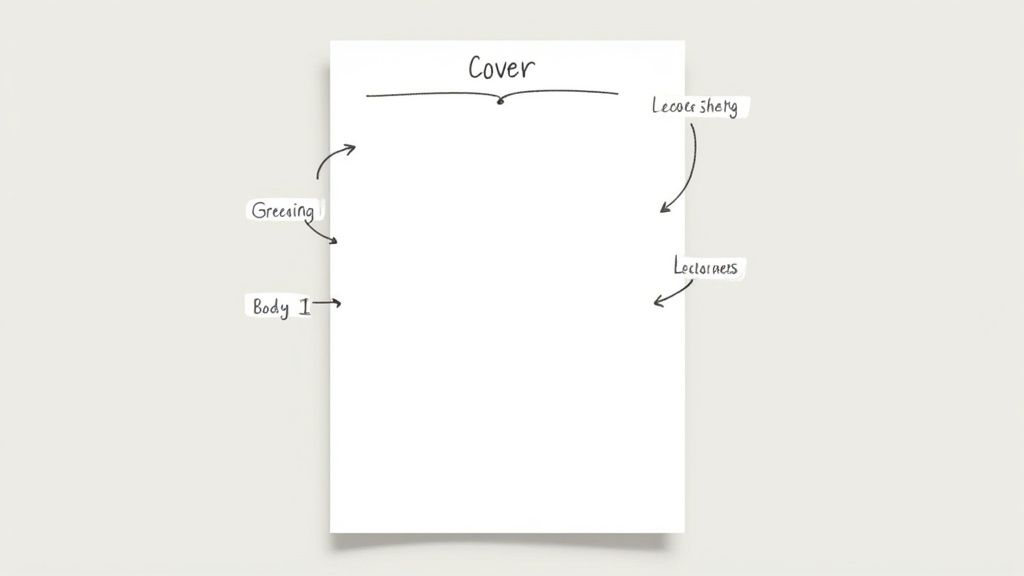
Go Beyond the Job Description
The job description is your starting point, not the whole map. To write a cover letter that truly lands, you have to dig a little deeper and understand what’s happening at the company right now. A few minutes of research is all it takes to find the details that make your message feel authentic and informed.
Your goal is to find a few talking points that prove you’ve done your homework.
- Recent Company News: Did they just launch a new product, close a funding round, or win an award? Mentioning a recent, positive development shows you’re keeping up with their journey.
- Industry Challenges: What are the biggest headwinds or opportunities in their market? Tying an industry trend back to how you can help them navigate it shows you think strategically.
- Company Values and Mission: Read their “About Us” page. If they champion sustainability and you have experience with green initiatives, that’s a powerful connection to highlight.
A personalized cover letter shows you’ve invested time and effort. It tells the hiring manager, “I see what you’re doing, I admire it, and I have the specific skills to help you do it even better.”
Mirror Their Language Authentically
Every company has its own dialect. Some are buttoned-up and corporate, while others are casual and speak in startup shorthand. Pay close attention to the tone and specific keywords they use in the job description and across their website.
When you mirror this language, you’re subtly showing that you get their culture and would fit right in. If they’re all about “collaboration,” “agile,” and “cross-functional teams,” weave those concepts into your stories. If their mantra is being “customer-obsessed,” share an anecdote where you went the extra mile for a client.
This isn’t about copy-pasting their phrases. It’s about speaking their language to show you already belong. Yes, this takes more effort, but it’s a crucial step in building rapport before you ever shake their hand. For those applying to many jobs, using a smart AI cover letter generator can help speed this up without watering down the quality.
From Bland to Targeted: An Example
Let’s see what this looks like in the real world. Imagine you’re applying for a Marketing Manager role at a B2B SaaS company that just launched a new AI-powered analytics tool.
The Generic Version (Before): “I am writing to express my interest in the Marketing Manager position. With over five years of marketing experience, I have a proven track record of developing successful campaigns and driving growth. I am confident my skills align with the requirements of this role.”
Honestly? It’s forgettable. That paragraph could be sent to any company for any marketing job.
The Personalized Version (After): “I was incredibly impressed by the recent launch of your new AI-powered analytics tool, especially given the industry’s shift toward data-driven decision-making. In my previous role at a B2B tech firm, I led the go-to-market strategy for a similar product, resulting in a 45% increase in qualified leads in the first quarter. I am excited by the opportunity to apply my experience in product marketing to help accelerate your tool’s market adoption.”
See the difference? This version is radically better.
- It’s Specific: It names the product and connects it to a relevant industry trend.
- It’s Quantifiable: That 45% increase is a concrete number that screams value.
- It’s Forward-Looking: It directly states how the candidate will help achieve a specific company goal (“accelerate your tool’s market adoption”).
This level of detail doesn’t just show you’re qualified; it shows you’re already thinking like part of the team. You’re no longer just another candidate—you’re a problem-solver who has already figured out how to make an impact. That’s the art of personalization, and it’s how you get the interview.
What Modern Hiring Managers Actually Want to Read
Let’s be honest: the era of the stuffy, ultra-formal cover letter is dead. If you’re still opening with lines like, “It is with great enthusiasm that I submit my application,” you might as well be sending it via horse and buggy.
Today’s hiring managers are drowning in applications. They aren’t looking for a formal essay; they’re looking for a human connection. They want to see your personality, understand what drives you, and get a quick, clear sense of how you can solve their problems. The goal has shifted from simply listing your qualifications to telling a compelling story about why you’re the right person for their team.
Brevity Is Your Best Friend
In a world of endless scrolling and shrinking attention spans, a long, rambling cover letter is a one-way ticket to the “no” pile. Think of it as your written elevator pitch—you have a precious few seconds to make a strong impression.
Recent research from MyPerfectResume and Jobera backs this up. In 2024, they found that while 83% of recruiters still believe cover letters are important, a massive 66% of job seekers now opt for letters that are half a page or less. This isn’t laziness; it’s a strategic shift. A powerful, concise message is simply more valuable than a page-long narrative. If you’re curious about different approaches, you can explore the 3 most effective cover letter formats that get results.
Every sentence has to earn its place. Cut the fluff and get right to the good stuff.
Show Them You’re a Problem-Solver
Companies don’t post job openings because things are running perfectly. They have a problem they need to solve, a gap they need to fill, or a goal they need to hit. Your cover letter is your first and best chance to position yourself as the solution.
This means you have to go beyond just restating your resume. You need to connect your accomplishments directly to the challenges you see in the role.
- Weak: “I have five years of experience in project management.”
- Strong: “I noticed the job description mentions a need for streamlining workflows. At my last company, I led the charge on implementing a new PM system that cut our project delivery times by 15%.”
See the difference? The second example doesn’t just state a skill; it shows a direct, quantifiable impact on a business problem. That’s what grabs a hiring manager’s attention.
Your cover letter shouldn’t be a passive summary of your past. It should be an active, forward-looking argument for how you will solve the company’s future problems.
Inject Personality Without Being Unprofessional
One of the biggest blunders I see is candidates writing in a robotic, corporate drone voice. While professionalism is non-negotiable, you also need to sound like a real person—someone they could actually imagine grabbing coffee with.
Striking that balance between conversational and professional is the secret sauce. It shows confidence and helps you build rapport before you even step into an interview. This is your chance to let your authentic enthusiasm for the company’s mission or products shine.
Mention a specific project of theirs you admired. Talk about a value on their “About Us” page that genuinely resonated with you. This tiny bit of personalization proves you’ve done your homework and aren’t just spamming your resume everywhere. For more ideas on how to frame your skills, check out our guide with the best resume writing tips.
Ultimately, a great modern cover letter is less about following rigid rules and more about making a strategic, personal connection. It’s your chance to prove you’re not just a list of skills, but a thoughtful, capable human who gets what they need and is ready to make a real impact.
Adapting Your Cover Letter for Different Industries
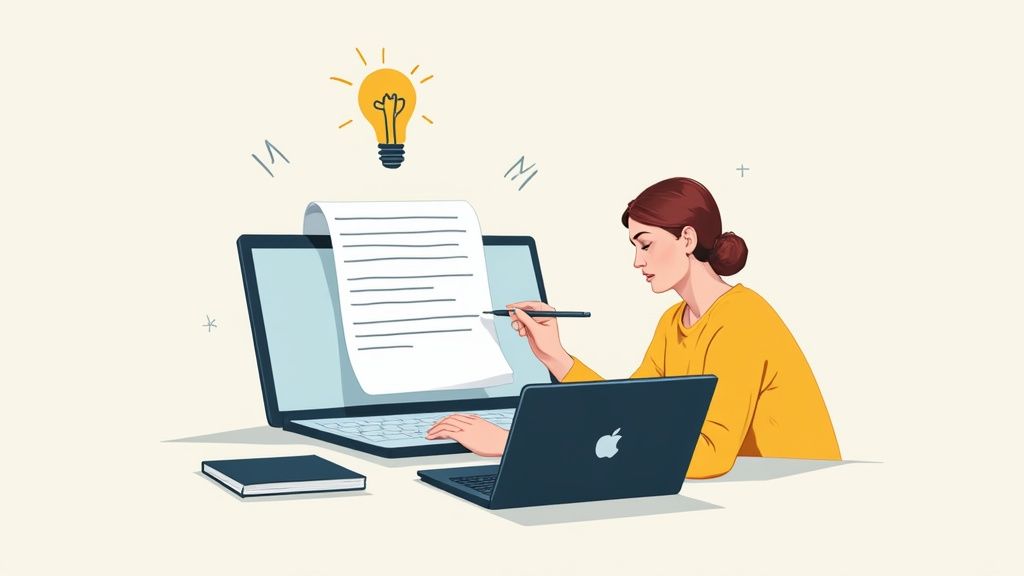
The cover letter that gets you an interview at a tech startup will almost certainly get tossed in the trash at a traditional law firm. This is one of the most common mistakes I see. People write one generic letter and send it everywhere, but different industries have wildly different expectations for tone, format, and what they want to see.
Your first job is to read the room. You need to match the industry’s culture. For conservative fields like finance, law, or government, a formal and structured letter isn’t just a suggestion—it’s a requirement. This means using a classic format, a professional tone, and getting straight to the point about your qualifications and measurable achievements.
On the other hand, creative industries like marketing, design, or media often expect you to show a bit of personality. This is your chance to be more conversational, maybe drop a link to your online portfolio, and let your genuine passion for the work come through. The idea is to prove you’re a creative thinker who gets their world.
For Traditional and Formal Industries
When you’re aiming for a role in a sector like banking or legal services, think precision and professionalism. Your cover letter needs to mirror the seriousness and sharp attention to detail that the job itself demands.
- Stick to a classic format: Use a clean header, a formal salutation (e.g., “Dear Ms. Rodriguez”), and a standard closing. No need to reinvent the wheel here.
- Keep the language professional: Avoid slang, contractions, or an overly casual tone. It’s about showing respect for their established norms.
- Focus on credentials and impact: This is where you let the numbers do the talking. Highlight your experience with data-driven results and specific accomplishments that directly address the company’s needs.
For Creative and Modern Industries
Now, let’s say you’re applying to a fast-growing tech company or a boutique design agency. The playbook is completely different. These places often care just as much about cultural fit and innovation as they do about hard skills.
- Let your personality show: Use a more engaging and authentic voice. Tell a quick story or express genuine enthusiasm for their work.
- Link to your work: Don’t just tell them you’re good; show them. Include a link to your portfolio, GitHub profile, or a specific project you’re proud of.
- Prove you’ve done your homework: Mention a recent campaign they ran, a product feature you admire, or a trend in their space. It shows you’re already thinking like part of the team.
Think of your cover letter as a cultural audition. A formal letter shows you respect tradition in a conservative field. A creative one proves you can think outside the box for an innovative company. Matching the industry’s vibe is the first, and most important, step to showing you belong.
It’s also important to remember that some sectors are ditching old norms entirely. Take hospitality, for example, where the traditional cover letter is quickly losing its relevance. A 2023 survey found that a whopping 60% of hospitality job seekers believe a cover letter isn’t essential anymore. Even more striking, 42% admitted they wouldn’t even apply for a job if a letter was mandatory.
You can read more about this shift in the hospitality sector. It’s a powerful reminder of just how critical it is to understand the specific rules of the game for each industry before you even start writing.
Your Top Cover Letter Questions Answered
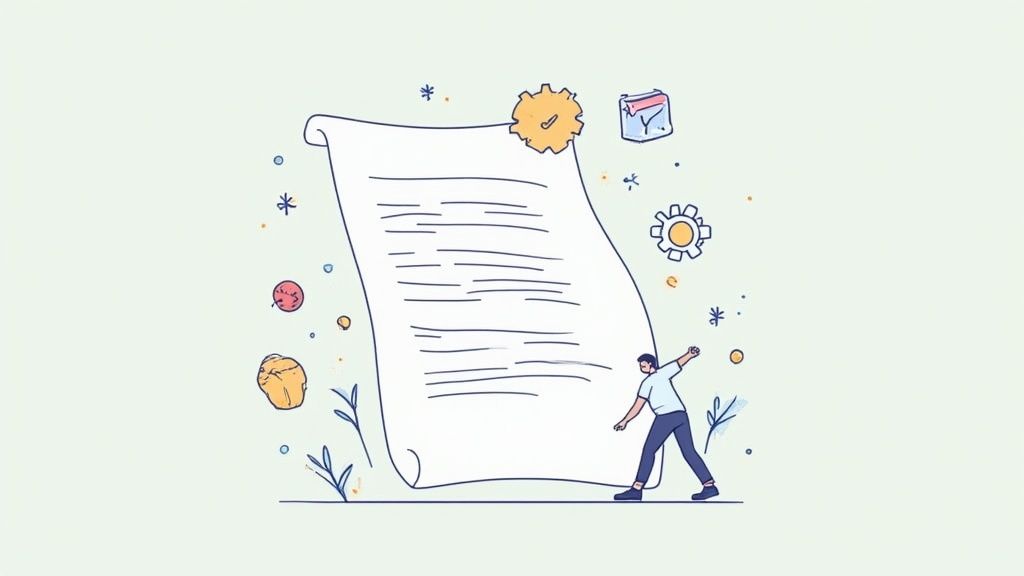
Even after you’ve got the basics down, a few tricky questions always seem to pop up right when you’re trying to finalize your cover letter. It’s these small details that can trip people up, but getting them right is what separates a good application from a great one.
Let’s walk through some of the most common questions I hear from job seekers. Answering these with confidence will give your application that final bit of polish it needs to land in the “yes” pile.
How Long Should a Cover Letter Be?
Keep it short and sweet. The sweet spot for a modern cover letter is between 250 and 400 words. That’s enough space to make a compelling case without testing a recruiter’s patience. Trust me, a powerful half-page letter beats a full-page essay every single time.
Your goal here is impact, not volume. Focus on your biggest wins and why you’re genuinely excited about this specific job. This isn’t the place to rehash your entire resume; it’s where you connect the dots and highlight your best stuff.
Think of it as a highlight reel, not the full feature film. A concise, powerful message proves you can communicate effectively and value the hiring manager’s time—two highly sought-after professional skills.
What if a Cover Letter Is Optional?
Always, always write one. When a job description says a cover letter is “optional,” what I see is a golden opportunity. This is your chance to leapfrog every other candidate who decided to take the easy way out. Sending one proves you’re willing to go the extra mile and that you’re serious about the role.
An optional cover letter gives you a platform to:
- Share a quick story about what connects you to the company’s mission.
- Explain what motivated you to apply for this job in the first place.
- Draw a direct line from your skills to their biggest challenges.
Most hiring managers will absolutely read a well-written optional letter. It can easily be the one thing that convinces them to give you a call.
How to Write a Cover Letter with No Experience
When you don’t have a ton of professional experience, your cover letter’s job becomes even more important. You can’t lean on past roles, so you have to shift the focus to your potential, your passion, and the skills you do have.
This is your chance to show them what you’re capable of, even without a traditional work history. Pull from other parts of your life to demonstrate your abilities.
- Academic projects are great for showing off research, teamwork, and problem-solving skills.
- Volunteer work proves you have initiative and a solid work ethic.
- Personal hobbies or side projects can showcase valuable skills like coding, graphic design, or event planning.
Your main goal is to prove you’ve done your homework and are hungry to learn. Show them you understand their mission and are genuinely excited to contribute. That kind of proactive enthusiasm can easily outweigh a lack of formal experience. Just be sure you understand the common mistakes to avoid in AI-generated cover letters—it’s critical that your letter sounds authentic, especially when your personality and potential are your biggest selling points.

